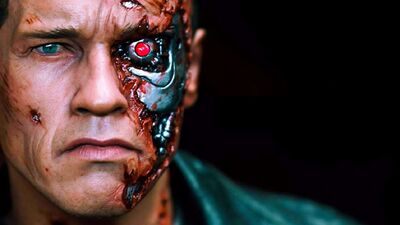The official discord link if you wish to join the discord: https://discord.gg/j5RKwCvAFu
Support the wiki on our official Ko-Fi page or Patreon page!
Category:Robots: Difference between revisions
| (One intermediate revision by the same user not shown) | |||
| Line 1: | Line 1: | ||
[[File:Terminator-Reboot-scaled.jpg|center|400px]] | |||
A '''robot''' is a machine—especially one programmable by a computer—capable of carrying out a complex series of actions automatically. A robot can be guided by an external control device, or the control may be embedded within. Robots may be constructed to evoke human form, but most robots are task-performing machines, designed with an emphasis on stark functionality, rather than expressive aesthetics. | |||
Robots can be autonomous or semi-autonomous and range from humanoids such as Honda's Advanced Step in Innovative Mobility (ASIMO) and TOSY's TOSY Ping Pong Playing Robot (TOPIO) to industrial robots, medical operating robots, patient assist robots, dog therapy robots, collectively programmed swarm robots, UAV drones such as General Atomics MQ-1 Predator, and even microscopic nano robots. By mimicking a lifelike appearance or automating movements, a robot may convey a sense of intelligence or thought of its own. Autonomous things are expected to proliferate in the future, with home robotics and the autonomous car as some of the main drivers. | |||
The word robotics, used to describe this field of study, was coined by the science fiction writer Isaac Asimov. Asimov created the "Three Laws of Robotics" which are a recurring theme in his books. These have since been used by many others to define laws used in fiction. (The three laws are pure fiction, and no technology yet created has the ability to understand or follow them, and in fact most robots serve military purposes, which run quite contrary to the first law and often the third law. "People think about Asimov's laws, but they were set up to point out how a simple ethical system doesn't work. If you read the short stories, every single one is about a failure, and they are totally impractical," said Dr. Joanna Bryson of the University of Bath.) | |||
Robotic characters, androids (artificial men/women) or gynoids (artificial women), and cyborgs (also "bionic men/women", or humans with significant mechanical enhancements) have become a staple of science fiction. | |||
[[Category:Characters]] | |||
Latest revision as of 18:18, 6 February 2023

A robot is a machine—especially one programmable by a computer—capable of carrying out a complex series of actions automatically. A robot can be guided by an external control device, or the control may be embedded within. Robots may be constructed to evoke human form, but most robots are task-performing machines, designed with an emphasis on stark functionality, rather than expressive aesthetics.
Robots can be autonomous or semi-autonomous and range from humanoids such as Honda's Advanced Step in Innovative Mobility (ASIMO) and TOSY's TOSY Ping Pong Playing Robot (TOPIO) to industrial robots, medical operating robots, patient assist robots, dog therapy robots, collectively programmed swarm robots, UAV drones such as General Atomics MQ-1 Predator, and even microscopic nano robots. By mimicking a lifelike appearance or automating movements, a robot may convey a sense of intelligence or thought of its own. Autonomous things are expected to proliferate in the future, with home robotics and the autonomous car as some of the main drivers.
The word robotics, used to describe this field of study, was coined by the science fiction writer Isaac Asimov. Asimov created the "Three Laws of Robotics" which are a recurring theme in his books. These have since been used by many others to define laws used in fiction. (The three laws are pure fiction, and no technology yet created has the ability to understand or follow them, and in fact most robots serve military purposes, which run quite contrary to the first law and often the third law. "People think about Asimov's laws, but they were set up to point out how a simple ethical system doesn't work. If you read the short stories, every single one is about a failure, and they are totally impractical," said Dr. Joanna Bryson of the University of Bath.)
Robotic characters, androids (artificial men/women) or gynoids (artificial women), and cyborgs (also "bionic men/women", or humans with significant mechanical enhancements) have become a staple of science fiction.
Pages in category "Robots"
The following 200 pages are in this category, out of 234 total.
(previous page) (next page)8
A
B
C
F
G
J
M
- Magic Man
- Magma Man
- Magnet Man
- Mama Tattletail
- Maneki-neko (Kamisama no Iutoori)
- Mangle
- Mars (Mega Man)
- Mecha Sonic (Sonic 2)
- Mechagodzilla (Monsterverse)
- Mega Man
- Mega Man (DOS)
- Mega Man (Smash Bros.)
- Mega Man (Tiger Electronic)
- Mega Man X
- Mega Man X (TerminalMontage)
- Mega Man?
- Mega Water S
- MegaMan Volnutt
- Mercury (Mega Man)
- Metal Man
- Mettaton
- Mirage (Ultrakill)
- Mothraya (Mega Man)
- Mr. Hippo
